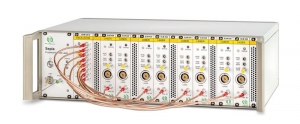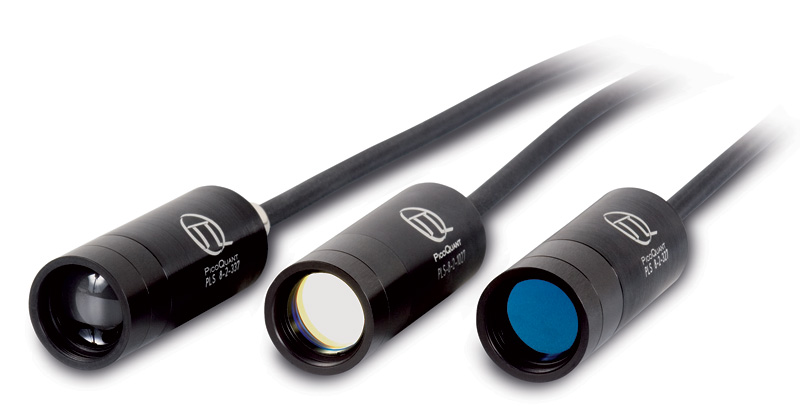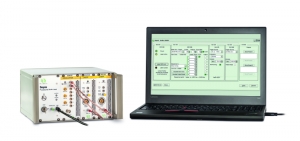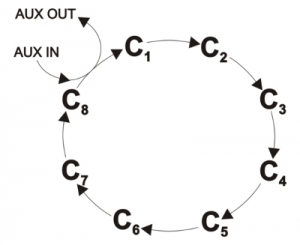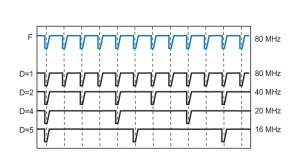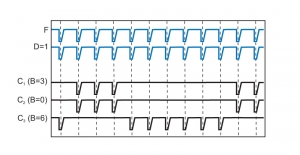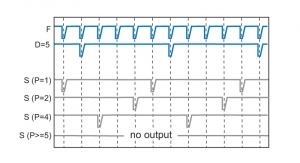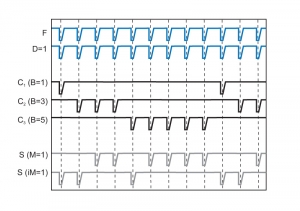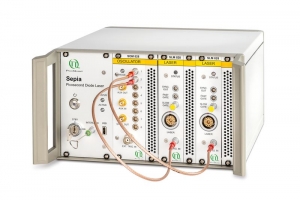Picosecond Pulsed Drivers
Sepia PDL 828
Multichannel Picosecond Diode Laser Driver
- Most flexible, modular system, for up to 8 laser heads
- Pulsed, burst and CW operation
- Ultimate flexibility in multichannel pulse patterns
- Easily controlled via USB
- Suited for LDH Series, LDH-FA Series, and PLS Series
- 5-year warranty
- Description
- Specifications
- Oscillator module
- Laser heads
- Applications
- Images
- Documents
- Publications
Contact us
 The Sepia PDL 828 is a multichannel driver for the picosecond pulsed laser diode heads of the LDH Series and LDH-FA Series as well as for the sub-nanosecond pulsed LEDs of the PLS Series. Wavelength changes are simply performed by plugging in a different laser or LED head.
The Sepia PDL 828 is a multichannel driver for the picosecond pulsed laser diode heads of the LDH Series and LDH-FA Series as well as for the sub-nanosecond pulsed LEDs of the PLS Series. Wavelength changes are simply performed by plugging in a different laser or LED head.
Ultra flexible driver solution
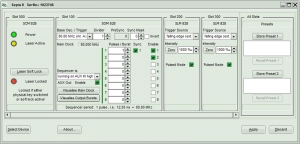 The Sepia PDL 828 provides maximum flexibility for multiple wavelengths applications. It drives any combination of up to eight laser or LED heads in parallel or in a user defined sequence. The whole system is easily configured and controlled through a dedicated Windows control software via a USB connection. Last settings are saved inside the Sepia PDL 828 to allow stand-alone operation, making it a powerful device for measurement automation. A computer library to access the functions of the Sepia PDL 828 for custom development is also provided with the device.
The Sepia PDL 828 provides maximum flexibility for multiple wavelengths applications. It drives any combination of up to eight laser or LED heads in parallel or in a user defined sequence. The whole system is easily configured and controlled through a dedicated Windows control software via a USB connection. Last settings are saved inside the Sepia PDL 828 to allow stand-alone operation, making it a powerful device for measurement automation. A computer library to access the functions of the Sepia PDL 828 for custom development is also provided with the device.
Individual modular assembly
The Sepia PDL 828 is available in different sizes to control any number of laser heads between 2 and 8 at the same time. Each Sepia PDL 828 is assembled individually from a mainframe with power supply and computer interface and two types of modules: the sepia oscillator module (SOM) and up to eight sepia laser driver modules (SLM). The communication between the SOM and the SLMs is achieved via external cabling. The SOM allows to produce a wide range of user-definable pulse patterns such as sequences or bursts. All connected laser heads can also be fired at the same time.
Powerful oscillator module (SOM 828-D)
 The sepia oscillator module (SOM 828-D) features eight individually addressable trigger outputs (output channels). It works as a rotary sequencer with programmable channels where one channel must be completed before the next one activates.
The sepia oscillator module (SOM 828-D) features eight individually addressable trigger outputs (output channels). It works as a rotary sequencer with programmable channels where one channel must be completed before the next one activates.
Additionally, the 8 channels of the module can be freely combined with each other to yield complex pulse patterns where one channel will activate simultaneously with its combination partners. Alternatively, instead of combining channels, an individual, software controlled delay can be introduced for any non-combined channel.
Both modules offer burst operation, where multiple pulses can be output from either single, grouped, or combined channels before the next channel becomes active. The sepia oscillator module has its own (variable) synchronization output, external trigger input as well as auxiliary input and output connectors.
Flexible laser driver module (SLM 828)
A sepia laser driver module is necessary for each laser head that needs to be connected and controlled at the same time by the Sepia PDL 828. The timing of the emitted pulses can be controlled by an external trigger signal, which is typically provided by the sepia oscillator module or any other source providing a NIM compatible signal. As a special feature, each sepia laser driver module can also operate independently from the other modules driven by its internal low-jitter oscillator at six fixed, user-selectable frequencies (80, 40, 20, 10, 5 or 2.5 MHz). All emitted laser pulses are accompanied by a synchronization output at the front panel of the laser driver module. This signal is always synchronised to the trigger source, independent from the selection of triggering mode (i.e. external or internal triggering).
Complete control of laser power and CW operation
The intensity of the laser emission is controlled via an internal voltage in steps of 0.1% of its full scale value. However, due to the non-linear behaviour of laser diodes, the voltage setting does not linearly correspond to the output power, i.e., a voltage of 50% does not correspond to 50% of the maximum output power. A special feature of the Sepia PDL 828 is to switch between CW and pulsed mode with the LDH-D Series of laser heads.
Gating inputs
For special applications using, e.g., scanning devices, the Sepia PDL 828 provides two special gating options that allow to suppress the laser emission by an external signal: A slow gate, that reduces setting times of the laser heads to a minimum at slow on / off periods (seconds) and a fast gate, that can perform transitions within nanoseconds, i.e., in between two pulses. The fast gate also provides high pulse stability when the on/off signal is periodic and fast (milliseconds).
For applications that require only a single wavelength, alternative single channel drivers can be provided (PDL 800-D, Taiko PDL M1).
| Mainframe | |
|---|---|
| Large, L: | 1 slot for oscillator module, 8 slots for laser driver modules |
| Small, S: | 1 slot for oscillator module, 2 slots for laser driver modules |
| Power supply | 115/230 VAC, 50/60 Hz, max. 350 Watts |
| Dimensions | large: 464 × 310 × 140 mm (w × d × h) |
| small: 250 × 310 × 140 mm (w × d × h) | |
| Oscillator module | |
| Outputs | 8 trigger (NIM), 1 synchronization (NIM), 1 auxiliary |
| Inputs | 1 external trigger, 1 auxiliary (TTL) |
| Operation mode | rotary, programmed sequence of one channel must be completed before next channel is activated, adjacent channels can be grouped; multiple channels can be either combined or delayed (SOM 828-D only) |
| Oscillator type | crystal locked |
| Master oscillator frequencies | 80, 64, 50 MHz (selectable) |
| Repetition frequency | user-selectable, derived from the selected master frequency or an external trigger source by division through any integer factor between 1 and 65 536 (SOM 828-D) |
| Jitter | 3-5 ps |
| Synchronization output | |
| Timing | synchronous to repetition frequency, timing position stepwise adjustable within the limits of the repetition frequency, stepsize equals master oscillator period |
| Masking | synchronization pulses can be inhibited (masked), mask size selectable in integer steps between 0 and 255, stepsize equals repetition period |
| Amplitude | < -800 mV into 50 Ohms (NIM) |
| Auxiliary output | |
| Timing | at start of complete trigger sequence |
| Amplitude | +500 mV into 50 Ohms (SOM 828); +1.5 into 50 Ohms (SOM 828-D) |
| External trigger input | |
| Amplitude | -5 to +5 V (maximum limits) |
| Trigger level | -1.2 to +1.2 V |
| Frequency range | up to 40 MHz |
| External synchonization | 6.25 to 100.00 MHz (SOM 828-D only) |
| Bursts | |
| Burst length | up to 16.7 million pulses |
| Laser driver module | |
| Operation mode | pulsed or continuous wave |
| Repetition frequency of internal oscillator |
80, 40, 20, 10, 5 or 2.5 MHz (user-selectable) |
| Jitter | typ. 3-5 ps |
| Outputs | 1 synchronization (NIM), laser head connector |
| Inputs | 1 trigger (NIM), 2 gating (TTL) |
| Detail gating inputs: | |
| - Slow gate | transition time < 100 ms (pulsed and CW) internal impedance > 500 Ohms connector type: 4-pin LEMO Socket - 00.304 Series example of connector: FGG.00.304.CLA |
| - Fast gate | transition time typ: 10 ns (pulsed only) internal impedance: 50 Ohms connector type: 1-pin LEMO Socket - 00.250 Series example of connector: FFA.00.250.NTA |
| Outputs | 1 synchronization (NIM), laser head connector |
| Operation mode | pulsed or continous-wave |
| Master oscillator frequency | 80 MHz |
| Repetition frequency | 80, 40, 20, 10, 5 or 2.5 MHz (user-selectable) |
| Computer | |
| Operating system | WindowsTM 11 |
| PC interface | USB 2.0 |
All Information given here is reliable to our best knowledge. However, no responsibility is assumed for possible inaccuracies or omissions. Specifications and external appearances are subject to change without notice.
Understanding the flexibility of the oscillator module
The SOM 828-D has a rotary sequencer with eight so-called burst channels that can each be addressed individually. These burst channels can be either activated individually one after another, grouped with adjacent channels, or freely combined for simultaneous activation. Burst operation can be enabled for single as well as grouped or combined burst channels, allowing outputting multiple pulses before the next channel becomes active. The SOM 828-D module allows introducing individual, software controlled delays in burst channels that are not combined. Additionally, the oscillator has its own synchronization output, external trigger input as well as auxiliary input and output connector.
The oscillator module has eight (individual) trigger outputs (channels) that can each be addressed individually. For example, channels can be combined to be activated at the same time or each channel can be individually activated in a sequence. To enable burst operation, multiple pulses can be output from one channel (or from combined channels) before the next channel becomes active. Additionally, the oscillator has its own synchronization output, an external trigger input as well as an auxiliary input and output connector.
Rotary working principle
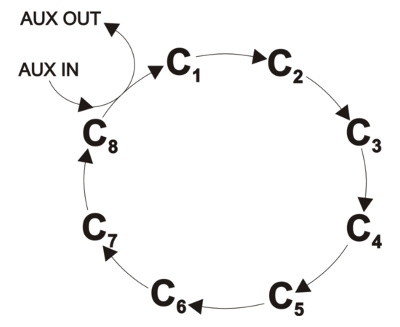 Generally speaking, the oscillator module works in a rotary fashion, meaning that the programmed sequence of burst channels 1 (C1) through 8 (C8) must be completed before the first one becomes active again. All channels can therefore be activated individually in a rotary sequence. Adjacent channels can also be combined for simultaneous operation. The SOM 828-D oscillator module even allows combining burst channels in any arbitrary fashion, so that the selected channel will output the same number of pulses at the same time as its combination partners do. The auxiliary input can be used to inhibit the oscillator from starting the output period, i.e., to "start" from channel 1. If the signal is provided during the rotation through the channels, one full sequencer period will be finished nonetheless. The auxiliary output is used to signal the start of a period. It is active when a period is finished (i.e., if channel 8 has been active) and a new one is about to start.
Generally speaking, the oscillator module works in a rotary fashion, meaning that the programmed sequence of burst channels 1 (C1) through 8 (C8) must be completed before the first one becomes active again. All channels can therefore be activated individually in a rotary sequence. Adjacent channels can also be combined for simultaneous operation. The SOM 828-D oscillator module even allows combining burst channels in any arbitrary fashion, so that the selected channel will output the same number of pulses at the same time as its combination partners do. The auxiliary input can be used to inhibit the oscillator from starting the output period, i.e., to "start" from channel 1. If the signal is provided during the rotation through the channels, one full sequencer period will be finished nonetheless. The auxiliary output is used to signal the start of a period. It is active when a period is finished (i.e., if channel 8 has been active) and a new one is about to start.
Repetition rates between 0.76 kHz or 196 kHz and 80 MHz
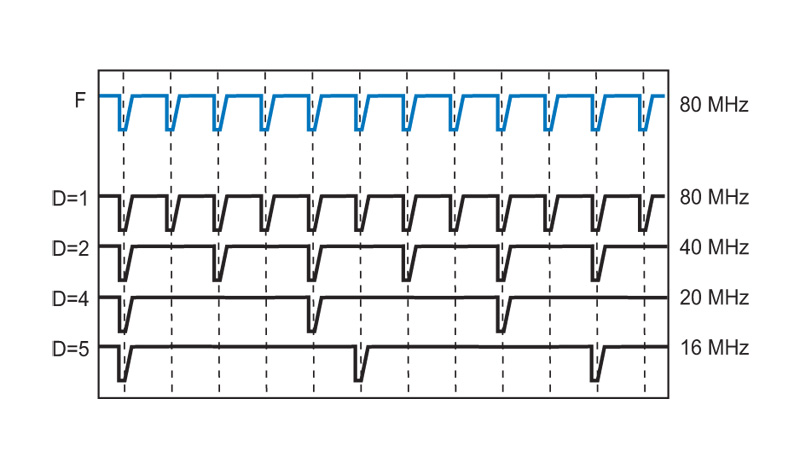 The oscillator modules of the Sepia PDL 828 provide a wide range of user selectable repetition rates to be used as the main clock rate. All repetition rates are in principle derived from an internal crystal oscillator along with an integer frequency divider. Both oscillator modules feature three internal user-selectable crystal oscillators with base frequencies (F) of 80, 64 and 50 MHz. Each base frequency can be further reduced by an integer division (D) ranging from 1 to 65 536. The highest repetition rate for both modules is therefore 80 MHz and the lowest repetition rates are 50 MHz/255~196 kHz and 50 MHz/65 536~0.76 kHz. It is also possible to provide an external trigger signal instead of using one of the internal oscillators. The frequency divider is also active on external trigger signals, thereby allowing virtually any repetition rate between single shot and 80 MHz.Repetition rates between 196 kHz and 80 MHz
The oscillator modules of the Sepia PDL 828 provide a wide range of user selectable repetition rates to be used as the main clock rate. All repetition rates are in principle derived from an internal crystal oscillator along with an integer frequency divider. Both oscillator modules feature three internal user-selectable crystal oscillators with base frequencies (F) of 80, 64 and 50 MHz. Each base frequency can be further reduced by an integer division (D) ranging from 1 to 65 536. The highest repetition rate for both modules is therefore 80 MHz and the lowest repetition rates are 50 MHz/255~196 kHz and 50 MHz/65 536~0.76 kHz. It is also possible to provide an external trigger signal instead of using one of the internal oscillators. The frequency divider is also active on external trigger signals, thereby allowing virtually any repetition rate between single shot and 80 MHz.Repetition rates between 196 kHz and 80 MHz
Defining bursts and combining channels
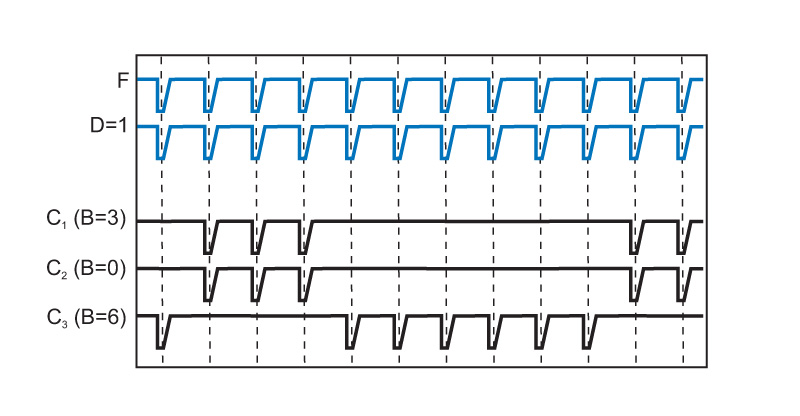 Both oscillator modules allow outputting any number of pulses between 1 and 16 772 215 (16.7 million) from one burst channel (C) before the next one becomes active (bursts - B). Adjacent burst channels can also be grouped to emit the same number of pulses at the same time, if the burst lengths of the channels following the first one to be grouped are set to 0. The SOM 828-D oscillator module furthermore allows free combining of burst channels. The target channel will output the same number of pulses at the same time as its combination partners.
Both oscillator modules allow outputting any number of pulses between 1 and 16 772 215 (16.7 million) from one burst channel (C) before the next one becomes active (bursts - B). Adjacent burst channels can also be grouped to emit the same number of pulses at the same time, if the burst lengths of the channels following the first one to be grouped are set to 0. The SOM 828-D oscillator module furthermore allows free combining of burst channels. The target channel will output the same number of pulses at the same time as its combination partners.
The pulse output from each channel can be enabled or disabled. However, if a burst channel is disabled, it is not "eliminated" from the rotary sequence. Instead, the programmed number of pulses is still processed, but simply no signal is present at the corresponding output port. This is useful to insert time gaps between two bursts.
Variable synchronization signal
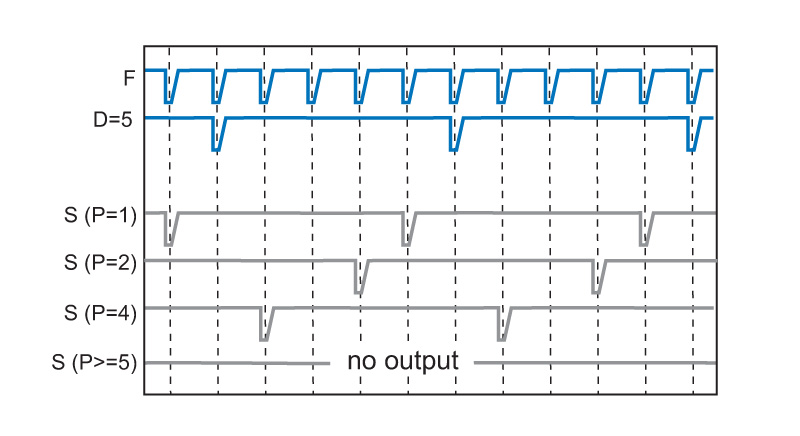 Each pulse that is output at any of the eight channels can be accompanied by a synchronization signal (S) at the sync out connector. This synchronization signal can be used to control external hardware like, e.g., providing the start pulse for a TCSPC system. It can be enabled and disabled individually for each channel. One special feature of the PDL 828 is that the synchronization signal can be time shifted at lower repetition frequencies. If the divider ratio is >1, the sync pulse can be moved within the main clock period (the divided signal) in steps of the crystal oscillator's period (pre-sync - P). If the pre-sync is set to a value equal or higher than the divider, the synchronization signal will be disabled.
Each pulse that is output at any of the eight channels can be accompanied by a synchronization signal (S) at the sync out connector. This synchronization signal can be used to control external hardware like, e.g., providing the start pulse for a TCSPC system. It can be enabled and disabled individually for each channel. One special feature of the PDL 828 is that the synchronization signal can be time shifted at lower repetition frequencies. If the divider ratio is >1, the sync pulse can be moved within the main clock period (the divided signal) in steps of the crystal oscillator's period (pre-sync - P). If the pre-sync is set to a value equal or higher than the divider, the synchronization signal will be disabled.
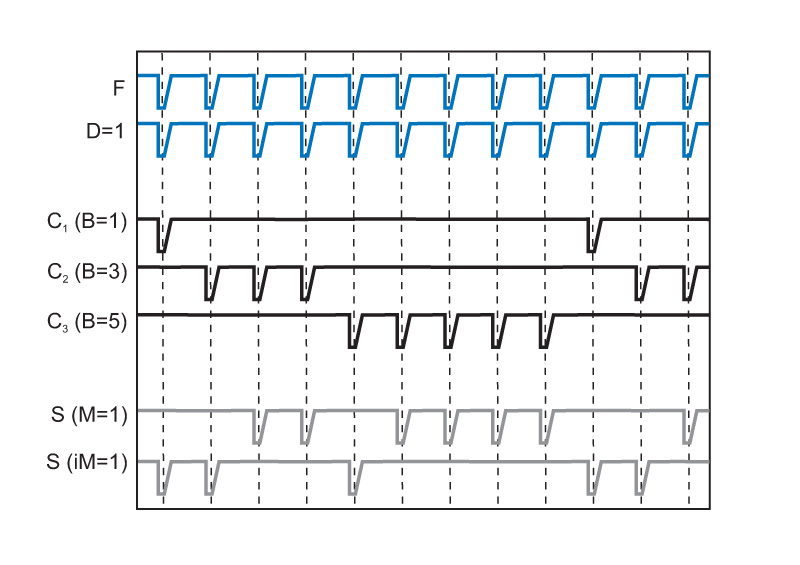 An additional option to influence the synchronization signal is to mask (M) a defined number of pulses. Masking in this context means that no synchronization signals are output. The number of omitted pulses can be set to any integer value between 0 and 255. The sync mask can also be inverted (iM), i.e., not the number of omitted pulses is specified, but the number of actual output pulses. Again, the number of inverted masked synchronization pulses can be set to any integer value between 0 and 255. A value of 0 leads to no synchronization output at all.
An additional option to influence the synchronization signal is to mask (M) a defined number of pulses. Masking in this context means that no synchronization signals are output. The number of omitted pulses can be set to any integer value between 0 and 255. The sync mask can also be inverted (iM), i.e., not the number of omitted pulses is specified, but the number of actual output pulses. Again, the number of inverted masked synchronization pulses can be set to any integer value between 0 and 255. A value of 0 leads to no synchronization output at all.
The Sepia PDL 828 is compatible with the picosecond pulsed sources listed below. Check out the corresponding product pages for more details.
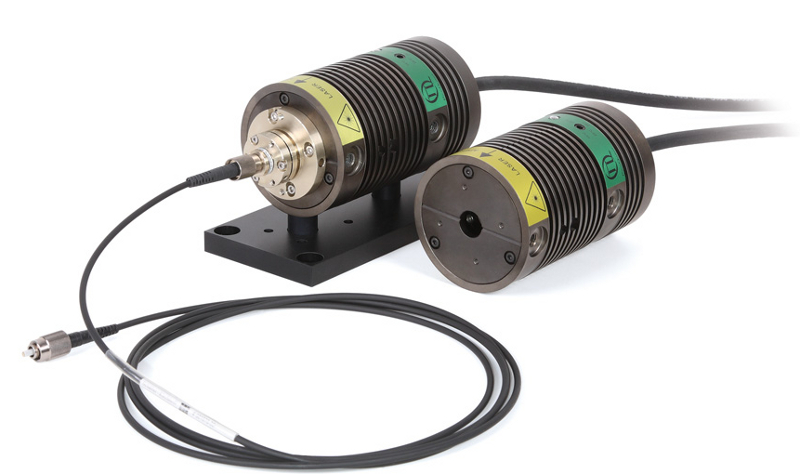 Picosecond Pulsed Diode Laser Heads
Picosecond Pulsed Diode Laser Heads
- Wavelengths between 375 and 1990 nm
- Pulse widths as short as 40 ps (FWHM)
- Adjustable (average) power up to 50 mW
- Repetition rate from single shot to 80 MHz
- Optional dual mode: pulsed and CW operation
- Collimating optics, optional fiber coupling and peltier cooling
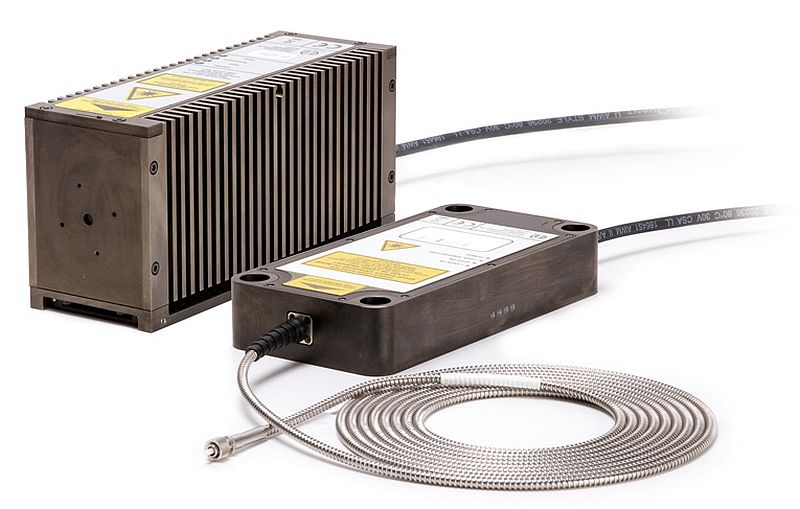 Amplified Picosecond Pulsed Laser Diode Heads
Amplified Picosecond Pulsed Laser Diode Heads
- Available wavelengths: 266, 355, 515, 531, 560, 766, 1064, and 1532 nm
- Pulse width down to 70 ps (FWHM)
- Average output power between 1 mW and 450 mW (depending on wavelength)
- Repetition rates up to 80 MHz
- Collimated beam or PM fiber output with FC/APC fiber connector
- Center wavelengths between 255 nm and 600 nm
- Pulse width down to 600 ps
- Adjustable (average) power up to 80 µW
- Repetition rate from single shot up to 40 MHz
- Optional bandpass filter
The Sepia PDL 828 along with the corresponding laser or LED sources can be used for various applications, where one or more excitation sources with short pulses, high and variable repetition rates as well as stable pulse energies are important, such as:
- Time-Resolved Fluorescence
- Fluorescence Lifetime Imaging (FLIM)
- Fluorescence Correlation Spectroscopy (FCS)
- Fluorescence Lifetime Correlation Spectroscopy (FLCS)
- Foerster Resonance Energy Transfer (FRET)
- Single Molecule FRET (smFRET)
- Stimulated Emission Depletion Microscopy (STED)
- Dual Focus Fluorescence Correlation Spectroscopy (2fFCS)
- Pulsed Interleaved Excitation (PIE)
- Alternative Laser EXcitation (ALEX)
- Hybrid Excitation (ALEX-PIE)
- Fluorescence Anisotropy (Polarization)
- Singlet Oxygen
- Laser Cutting/Ablation
- Time-Resolved Photoluminescence (TRPL)
- TRPL Imaging
- Fluorescence Upconversion
- LIDAR/Ranging/SLR
- Antibunching
- Diffuse Correlation Spectroscopy (DCS), Time Domain Diffuse Correlation Spectroscopy (TD-DCS)
- Diffuse Optical Tomography and Imaging
- Single Photon Generation
- Single Molecule Spectroscopy / Detection
The following documents are available for download:
- Datasheet Sepia PDL 828
- Brochure about PicoQuant's laser products
- New features of the software for the PDL 828
Latest 10 publications referencing Pulsed Diode Lasers (PDL Series, LDH-Series, LDH-FA Series)
The following list is an extract of 10 recent publications from our bibliography that either bear reference or are releated to this product in some way. Do you miss your publication? If yes, we will be happy to include it in our bibliography. Please send an e-mail to info@picoquant.com containing the appropriate citation. Thank you very much in advance for your kind co-operation.



